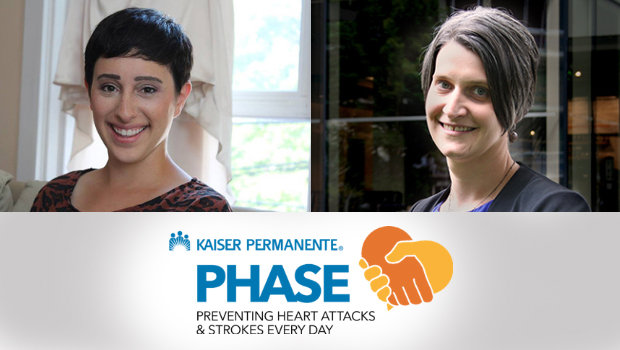Preventing heart attacks, strokes through health management

Carly Levitz (left) and Maggie Jones of the Center for Community Health and Evaluation discuss the lasting impact of the PHASE program.
How the PHASE program improved care for people at risk of cardiovascular disease
In 2004, Kaiser Permanente Northern California implemented a program to eliminate preventable cardiovascular disease (CVD) for its members. They called this program PHASE (Preventing Heart Attacks & Strokes Every Day). PHASE combined evidence-based medicine with population health management to reduce heart attacks and strokes by controlling risk factors. Seeing success from that internal program, Kaiser Permanente Northern California Community Health funded an initiative to support similar work for high-risk patient populations served by health care safety net providers in Northern California.
The PHASE in the Community initiative, which ran from 2007 through 2021, drew on clinical expertise from Kaiser Permanente and technical assistance provided by key partners such as the Center for Care Innovations. Over time, clinics improved outcomes after adopting and implementing PHASE clinical practices. At its peak, PHASE reached 209 health center and hospital sites and more than 230,000 patients with diabetes, hypertension, or CVD.
Over the past 10 years, the Center for Community Health and Evaluation (CCHE) at Kaiser Permanente Washington Health Research Institute (KPWHRI) has been the evaluation partner for the PHASE initiative. CCHE’s approach to evaluation (relationship-centered, formative, and real-time) supported the evolution of the program and helped the safety net organizations use data to drive improvements.
Maggie Jones, CCHE director, and Carly Levitz, an evaluation and learning associate with CCHE, recently answered questions about their experiences working with the PHASE initiative — discussing what key findings occurred during the initiative’s 15-year evolution, what challenges COVID-19 presented to the program’s implementation and success, and where PHASE is headed in the future.
What has CCHE learned about the overall impact of the PHASE program? How was PHASE successful?
Jones: By the end of PHASE, patients at risk for CVD were being reached by organizations implementing evidence-based practices to reduce the risk of heart attacks and strokes. Participating organizations improved blood pressure control rates, prescription rates for key medications, and screening rates for risk factors. The more structured learning collaborative also contributed to their progress by helping organizations set realistic aims, work toward them in a systematic way, and learn from experts and each other along the way.
What were some of the other key findings from CCHE’s evaluation?
Levitz: We began our evaluation in 2012 conducting a retrospective evaluation of the first 5 years of PHASE. Primary care clinics were able to more effectively implement the PHASE medication protocol when they were supported with strong quality improvement infrastructure, data analytics, team-based care, proactive population health management practices, and a supportive culture. The long-term funding and technical assistance supported participating organizations in building these capacities.
What opportunities did PHASE provide for peer learning?
Jones: The approach to peer learning evolved over time. Throughout PHASE there were at least annual convenings that brought together participating safety net organizations with Kaiser Permanente representatives to share learnings and developments. In later years, they established a more formal learning community with more frequent and structured opportunities for peer learning. Organizations participating in PHASE consistently rated the convenings as one of the most valuable parts of PHASE and could identify specific examples of how what they learned during those meetings informed their clinical practice and quality improvement efforts. An important factor in this peer sharing was that all organizations were focused on the same outcomes. This enabled them to share concrete solutions that could be applied to their own projects more readily than if they all were working on improving different outcomes.
How did COVID-19 issues affect the project? What tactics helped organizations adjust to the pandemic?
Levitz: COVID-19 and the resulting stay-at-home orders transformed how health care was delivered. Many of the chronic care management practices that PHASE established were based on an in-person care model — for example, monitoring blood pressure, screening for tobacco use or depression, etc. Organizations had to rethink how they managed all chronic conditions. Many began exploring remote patient monitoring programs for blood pressure control. This involved providing patients with blood pressure cuffs and finding ways to have patients communicate their measurements back to the care teams, so that they could modify treatment plans remotely as needed. Organizations also experimented with drive-through COVID-19 testing sites combined with blood pressure measurement or hemoglobin A1c testing (to measure average blood sugar levels), along with screening for other risk factors.
What are the next steps with PHASE? How is it being sustained?
Jones: There are many ways to think about sustainability. The participating organizations reported that much of the work they had done through PHASE has been institutionalized and is now standard care. Additionally, organizations are applying what they learned about supporting patients at risk of CVD to other chronic conditions. These organizations are also committed to furthering work to reduce the impact of inequities related to race and language on people’s health outcomes. Kaiser Permanente launched the Virtual Care Innovation Network to support safety net organizations with the transition to telehealth that resulted from the pandemic. Within that initiative, there is a cohort focused on remote patient monitoring.
Details of how PHASE successfully improved blood pressure control for patients with diabetes can be found in the Journal for Healthcare Quality.